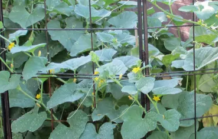VEGETABLES
Storing Potatoes in Cold Temperatures
Potatoes stored below 40 degrees F will not sprout and will remain firm for long periods. However, such storage will often lead to starches being converted to sugars, which will give tubers an undesirable sweet taste. Placing potatoes at room temperature for 2 to 3 days will allow sugars to be converted back to starches and remove the objectionable taste. (Ward Upham)
FLOWERS
Care of Christmas and Thanksgiving Cacti
Christmas Cactus (Schlumbergera bridgesii) and Thanksgiving Cactus (Schlumbergera truncata) are epiphytes native to the jungles of South America. Epiphytic plants grow on other plants and use them for support but not for nutrients. Though these cacti are different species, they will hybridize and produce varying stem shapes. Christmas cactus normally has smooth stem segments, and Thanksgiving Cactus has hook-like appendages on each segment.
Both of these cacti prefer bright indirect light. Too much sun can result in the leaves turning yellow. Common household temperatures are fine. Soil should be kept constantly moist but not waterlogged. Give them a light fertilization every other week. Blooming will normally cease in late winter to early spring, but continue to keep them moist and fertilized until fall. During the fall, stop fertilizing, and give the plants only enough water so the stems do not shrivel in order to encourage flower bud formation. Though these plants seem to flower best if kept a little pot bound, flowers will diminish if they are too crowded. If you haven’t repotted in several years, or if you notice a decrease in flowering from the previous year, move the plant to a larger pot in the spring. If possible, move the plants outside for the summer. Choose a shady spot because these plants will not tolerate full sun. Leave the plants outside until frost threatens.
Normally, the plants will have received enough cool nights in the 50- to 55-degree range that flower buds will have formed. However, if they haven’t, subjecting the plants to nights greater than 12 hours long and temperatures between 59 and 69 degrees can also generate flowers. Twenty-five consecutive long nights is enough for flower initiation. Place the plants in an unused room or cover them with a dark cloth or cardboard box to insure that they receive uninterrupted darkness. After the flower buds have formed, it takes an additional nine to 10 weeks for flowers to complete development and bloom. (Ward Upham)
ORNAMENTALS
Choosing and Caring for Your Christmas Tree
If selecting a cut tree, watch for these signs that the tree is too far gone.
– Needles are a dull, grayish-green color
– Needles fail to ooze pitch when broken apart and squeezed
– Needles feel stiff and brittle
– Needles pull easily off tree
Once you have your tree home, recut the trunk about one inch above the original cut. This will open up clogged, water-conducting tissues. Immediately place the trunk in warm water.
Locate the tree in as cool a spot as possible. Avoid areas near fireplaces, wood-burning stoves and heat ducts as the heat will result in excess water loss. Make sure the reservoir stays filled. If the reservoir loses enough water that the bottom of the trunk is exposed, the trunk will need to be recut. Adding aspirins, copper pennies, soda pop, sugar and bleach to the water reservoir have not been shown to prolong the life of a tree.
If you choose a living Christmas tree, be sure to dig the planting hole before the ground freezes. Mulch the hole and backfill soil to keep them from freezing. Live trees should not be kept inside for more than three days. Longer periods may cause them to lose dormancy resulting in severe injury when planted outside. You may wish to tag the tree at the nursery and then pick it up a couple days before Christmas. After Christmas, move the tree to an unheated garage for several days to acclimatize it to outside temperatures. After planting, water well and leave some mulch in place to prevent the soil water from freezing and becoming unavailable for plant uptake. (Ward Upham)
MISCELLANEOUS
Firewood
Not all firewood is created equal. Some species of trees are able to produce much more heat per cord of wood. A cord is the amount of wood in a well-stacked woodpile measuring 4 feet wide by 8 feet long by 4 feet high.
Following are heat values (in million BTUs) per cord for various species of trees. The higher the value, the better the wood.
For questions or further information, contact: wupham@ksu.edu OR cdipman@ksu.edu
This newsletter is also available on the World Wide Web at:
http://hnr.k-state.edu/extension/info-center/newsletters/index.html




